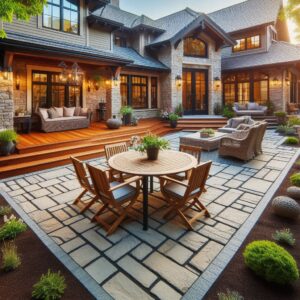Home Improvement
Hardscape Patios: The Key to a Beautiful and Functional Outdoor Living Area
Key Takeaways
- Hardscape patios enhance the beauty and usability of outdoor spaces.
- Proper planning and material selection are crucial for long-lasting patios.
- Eco-friendly options are available for sustainable outdoor designs.
- Incorporating local greenery complements hardscape features.
Table of Contents
- Understanding Hardscapes and Their Benefits
- Selecting Materials for Your Patios
- Design Tips for a Functional Outdoor Space
- Incorporating Eco-friendly Practices
- Complementary Landscape Elements
- Maintenance Tips for Longevity
- Boosting Property Value with Hardscaping
Understanding Hardscapes and Their Benefits
In landscaping, hardscape patios are a cornerstone for creating functional and appealing outdoor spaces. Hardscaping refers to the non-living elements, such as pathways, patios, and retaining walls, that provide structure and design. These features enhance a property’s aesthetic appeal and improve its usability, allowing for designated entertainment and relaxation areas.
One of the primary benefits of incorporating hardscape elements is their durability and low-maintenance nature. Unlike grass or other landscapes that require regular upkeep, hardscapes are designed to withstand diverse weather conditions, offering a long-lasting solution for outdoor enjoyment. Moreover, the versatility of hardscapes allows homeowners to customize their spaces to reflect personal tastes and lifestyles, making patios not just an extension of the home but a statement piece in their own right.
Selecting Materials for Your Patios
The choice of materials is crucial in crafting a hardscape patio that meets your expectations in functionality and style. Concrete is a popular option due to its durability and affordability, while natural stone offers an elegant, timeless look that can be tailored to any design aesthetic. Bricks are another classic choice, providing a warm, inviting appearance with excellent longevity, and can be laid in various patterns to add unique visual interest. Well-designed hardscape patios enhance the aesthetic appeal of your outdoor space and provide a durable and low-maintenance area for relaxation and entertainment.
When selecting materials, consider the climate and how various options will perform over time. For instance, in regions prone to temperature fluctuations, you might opt for materials that can expand and contract without cracking. Properly mixed and poured concrete can withstand freeze-thaw cycles better than other materials. The vast design possibilities allow homeowners to create spaces that reflect personal tastes while serving practical purposes. Choose colors, patterns, and textures that complement the existing environment and planned use of the space. For professional installation and long-lasting results, companies like evergreen outdoor concrete service offer concrete services, including site preparation, installation, and decorative finishes, ensuring patios remain beautiful and durable.
Design Tips for a Functional Outdoor Space
Effective design starts with careful planning. Think about how you wish to use the space, whether for hosting large gatherings, private family time, or even solitary relaxation. Define the flow from your indoor to outdoor areas, using visual and physical cues to connect spaces seamlessly. Thoughtful design can transform even modest outdoor areas into functional havens for relaxation and entertainment.
Incorporate features like built-in seating, planters, or fire pits to add versatility and appeal. These components make the space inviting and multifunctional, catering to various activities and moods. Various elevations and levels can add structural interest and define different activity zones. Strategic lighting enhances usability after dark and highlights key areas of interest, ensuring the patio remains a hub of activity day and night. To pull these elements together, consulting with professionals in landscaping and landscape design, who also understand regional conditions, can help you choose materials and layouts that age well and require less maintenance. This can ensure long term performance and ensure that the space remains comfortable and functional through seasonal changes.
Incorporating Eco-friendly Practices
As environmental concerns grow, sustainable options in hardscaping have become essential. Use permeable materials to allow rainfall to naturally infiltrate the ground, reducing runoff and maintaining groundwater levels. These choices form part of broader green infrastructure strategies that aim to harmonize man-made and natural environments. Utilizing local, sustainably sourced materials can also greatly reduce the carbon footprint of patio projects.
Recycling existing materials is another eco-friendly technique that reduces waste and preserves resources. For instance, reclaimed wood and stone can lend rustic charm while meeting sustainability goals. Such practices not only benefit the environment but can also enhance the aesthetic uniqueness of your patio.
Complementary Landscape Elements
Blend your hardscape with green elements to create a truly magnificent outdoor space. Integrating native plants and shrubs can enhance the visual appeal of your patio while providing habitats for local wildlife. This biodiversity is vital for the sustainability of the ecosystem surrounding your home. Additionally, native plants require less maintenance and watering, further supporting sustainable landscaping efforts.
Consider planting in layers to add depth and interest, using ground covers, tall shrubs, and climbers to make the most of vertical space. This approach can create a lush, inviting atmosphere that complements the solidity of the hardscape. Adding a water feature, like a small pond or fountain, can introduce soothing sounds and additional wildlife attractions, enhancing the overall sensory experience of your patio area.
Maintenance Tips for Longevity
While hardscapes require less maintenance than traditional landscapes, some upkeep is necessary to ensure longevity. Regular cleaning and using a power washer for surfaces like stone and concrete will keep your patio looking fresh and new. Removing debris and grime also helps prevent staining and wear over time, ensuring your hardscape remains attractive.
It is also essential to promptly address minor repairs, such as cracks or loose stones. This attention to detail prevents small issues from developing into more significant problems, preserving the integrity and appearance of your patio. Sealing the surfaces appropriately helps protect against weather and wear. Seasonal inspections allow you to assess areas needing attention, ensuring your patio stays in top condition year-round.
Boosting Property Value with Hardscaping
A well-designed hardscape patio enhances daily living and increases your property’s market value. Prospective buyers often seek properties with established outdoor living areas, which can serve as an extension of the home’s usable space. A thoughtfully constructed patio showcases high-quality craftsmanship and an eye for design, which attract discerning buyers.
Investing in high-quality materials and thoughtful design can result in a substantial return for selling. As outdoor living spaces gain popularity, hardscape patios remain a wise investment for homeowners looking to enjoy and profit from their properties. Consider adding technologically savvy features such as built-in media stations or heating elements to enhance modern appeal.





